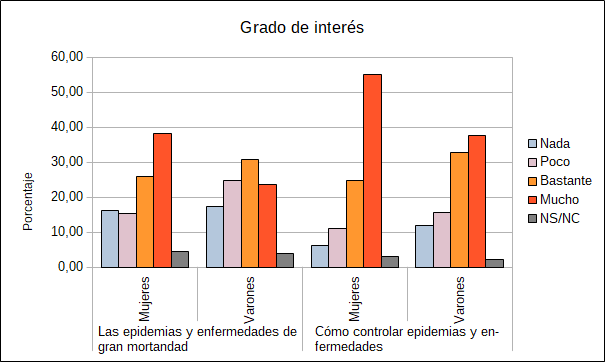Epidemics, Health and Science: Interest and Perception of Students of Public Schools of Buenos Aires Conurbation before COVID-19
Main Article Content
Abstract
In this article we describe the degree of interest of students from public schools of Hurlingham (Buenos Aires), regarding various aspects related to epidemics and health, as well as their perception of science, technology and scientists. Data were collected during 2019 using the ROSE Project questionnaire and, therefore, they reflect the interests of students prior to the pandemic. We found a strong belief that science and technology will provide cures for diseases of greatest concern. The three items that aroused the most interest were: How to perform first aid and use basic medical equipment, Cancer: what we know and how to treat it, and How to control epidemics and diseases. We believe that the information presented here provides a framework to quantify the changes that the COVID-19 pandemic may generate.
Article Details

This work is licensed under a Creative Commons Attribution-NonCommercial-ShareAlike 4.0 International License.
Aquellos autores/as que tengan publicaciones con esta revista, aceptan los términos siguientes:- Los autores/as conservarán sus derechos de autor y garantizarán a la revista el derecho de primera publicación de su obra, el cuál estará simultáneamente sujeto a la Licencia de reconocimiento de Creative Commons que no se permite un uso comercial de la obra original ni de las posibles obras derivadas, la distribución de las cuales se debe hacer con una licencia igual a la que regula la obra original.
- Los autores/as podrán adoptar otros acuerdos de licencia no exclusiva de distribución de la versión de la obra publicada (p. ej.: depositarla en un archivo telemático institucional o publicarla en un volumen monográfico) siempre que se indique la publicación inicial en esta revista.
- Se recomienda a los autores/as difundir su obra a través de Internet (p. ej.: en archivos telemáticos institucionales o en su página web) después del proceso de publicación, lo cual puede producir intercambios interesantes y aumentar las citas de la obra publicada. (Véase El efecto del acceso abierto).
How to Cite
References
Beck, U. (1992). Risk Society: Towards a New Modernity. London: Sage publications.
Driver, R., Leach, J., Millar, R. y Scott, P. (1996). Young people's images of science. London: Open University Press.
Giddens, A. (1991). Modernity and self-identity. Self and society in the late modern age. Cambridge: Polity press.
González Díaz, C (2015). La comunicación en salud como premisa fundamental para la percepción de riesgo en las poblaciones. Revista Cubana de Higiene y Epidemiología, 53(2).
González, P. (27 de diciembre de 2016). Jugada preparada. El gato y la caja. Disponible en: https://elgatoylacaja.com.ar/jugada-preparada/
INDEC. (2010). Censo Nacional de Población, Hogares y Viviendas 2010: REDATAM + SP [base de datos]. Buenos Aires: INDEC. Disponible en: http://www.indec.gob.ar
Jones, M.G., Howe, A., y Rua, M. (2000). Gender differences in students’ experiences, interests, and attitudes toward science and scientists. Science Education. Vol. 84 (2): 180-192.
Lederman, N.G. (2007). Nature of Science: Past, Present, and Future (pp. 831-880). En S.K. Abell y N.G. Lederman (Eds.), Handbook of research on science education. Routledge.
Mazzitelli, C.A. y Aparicio, M.T. (2009). Las actitudes de los alumnos hacia las Ciencias Naturales, en el marco de las representaciones sociales, y su influencia en el aprendizaje. Revista Electrónica de Enseñanza de las Ciencias, 8(1): 193-215.
Miller, P.; Slawinski Blessing, J. y Schwartz, S. (2007). Gender Differences in High‐school Students’ Views about Science. International Journal of Science Education, 28(4): 363-381.
MINCYT (2012). Ministerio de Ciencia, Tecnología e Innovación Productiva. Tercera Encuesta Nacional sobre la percepción de los argentinos sobre la investigación científica en el país. Disponible en: https://www.argentina.gob.ar/sites/default/files/percepcion_publica_2012.pdf
MINCYT (2016). Ministerio de Ciencia, Tecnología e Innovación Productiva Cuarta Encuesta Nacional de Percepción Pública de la Ciencia: la evolución de la percepción pública de la ciencia y la tecnología en la Argentina, 2003-2015. Disponible en: https://www.argentina.gob.ar/sites/default/files/percepcion_publica_2015.pdf
Moran, K.R. y Del Valle, S.Y. (2016). A Meta-Analysis of the Association between Gender and Protective Behaviors in Response to Respiratory Epidemics and Pandemics. PloS one, 11(10), e0164541. doi:10.1371/journal.pone.0164541
MSN (2020). Ministerio de Salud de la Nación. Recomendación de productos de limpieza domiciliaria y productos de uso domiciliario activos. Ministerio de Salud de la Nación. 2 de abril de 2020. Disponible en: http://www.msal.gob.ar/images/stories/bes/graficos/0000001882cnt-20200403-recomendaciones-productos-limpieza-domiciliaria.pdf.
Petrucci, D. y Pedrosa, J. (2019). Primeros pasos de un estudio sobre la relevancia de la educación en ciencias en Hurlingham. Revista de Enseñanza de la Física, 31 (Número Extra): 11-29
Petrucci, D., Bergero, P. y Pedrosa, J. (2019). Sobre la elección de carreras científicas y tecnológicas. Revista de Enseñanza de la Física, 31 (Número Extra): 589-596
Plohl, N. y Musil, B. (2020). Modeling compliance with COVID-19 prevention guidelines: the critical role of trust in science. Psychology, Health & Medicine, 1–12. doi:10.1080/13548506.2020.1772988
Ruina, M. (2010). Los científicos, los periodistas y el público: tres protagonistas en la comunicación pública de la ciencia. Revista de Educación en Biología, 13(2): 46-51. Recuperado a partir de https://revistas.unc.edu.ar/index.php/revistaadbia/article/view/22301
Schreiner, C. y Sjøberg, S. (2004). Sowing the seeds of ROSE. Background, Rationale, Questionnaire Development and Data Collection for ROSE (The Relevance of Science Education). Acta Didactica, 4. https://roseproject.no/key-documents/key-docs/ad0404-sowing-rose.pdf
Secretaría Académica, UNAHUR (2018). Informe Sociodemográfico Estudiantes Unahur. Universidad Nacional de Hurlingham. Informe con las elecciones de los aspirantes del año 2018.
SECYT (2007). Secretaría de Ciencia, Tecnología e Innovación Productiva. Segunda Encuesta Nacional sobre la percepción de los argentinos sobre la investigación científica en el país.
Sjøberg, S. y Schreiner, C. (2010). The ROSE Project. An overview and key findings. Disponible en: https://roseproject.no/network/countries/norway/eng/nor-Sjoberg-Schreiner-overview-2010.pdf
Sjøberg, S. y Schreiner, C. (2019). ROSE (The Relevance of Science Education). The development, key findings and impacts of an international low cost comparative project. Final Report, Part 1 (of 2). Disponible en: https://www.researchgate.net/publication/335664683_ROSE_The_Relevance_of_Science_Education_The_development_key_findings_and_impacts_of_an_international_low_cost_comparative_project_Final_Report_Part_1_of_2
Soto, C.J. y John, O.P. (2017). The next Big Five Inventory (BFI-2): Developing and assessing a hierarchical model with 15 facets to enhance bandwidth, fidelity, and predictive power. Journal of Personality and Social Psychology, 113(1): 117–143. https://doi.org/10.1037/pspp0000096

